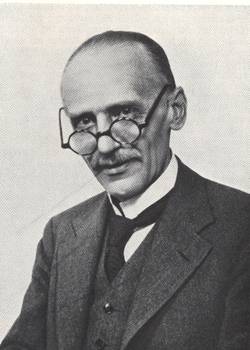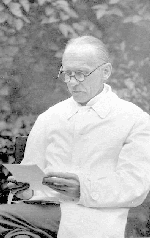<Back to Index>
- Neurologist Otfrid Foerster, 1873
- Writer Émile Gaboriau, 1832
- 1st Director of the Peace Corps Robert Sargent Shriver, Jr., 1915
PAGE SPONSOR


Otfrid Foerster (9 November 1873 in Breslau, Silesia – 15 June 1941, also in Breslau) was a German neurologist and neurosurgeon, who made innovative contributions to neurology and neurosurgery, such as rhizotomy for the treatment of spasticity, anterolateral cordotomy for pain, the hyperventilation test for epilepsy, Foerster's syndrome, the first electrocorticogram of a brain tumor, and the first surgeries for epilepsy. He is also known as the first to describe the dermatomes (an area of skin that is supplied by a single pair of dorsal nerve roots), and he helped map the motor cortex of the cerebrum.
Foerster was born in Breslau, and studied in the Maria Magdalenen Gymnasium, graduating 1892. From 1892 to 1896 he studied medicine in Freiburg, Kiel and Breslau, obtaining his licensure by state examination in 1897 and his doctorate in the same year. Upon completion of the doctoral studies, he spent two years studying abroad, following a suggestion by Karl Wernicke (1848 - 1905): in the summer he went to Paris, studying with Joseph Jules Dejerine and attending classes by Pierre Marie and Joseph Babinski (1857 - 1932); and in the summer with Heinrich Frenkel in Switzerland, in order to study physical therapy of neurological patients there.
Foerster's student years occurred in a time when neurology was starting to develop independently from internal medicine and psychiatry under the influence of, among others, Jean - Martin Charcot (1825 - 1893), Wilhelm Heinrich Erb, William Richard Gowers (1845 - 1912) and particularly Karl Wernicke, who became well known by his direction toward functional localization approaches. By cooperating with Wernike, Foerster's great interest on the anatomy of the central nervous system was excited. The two researchers published together in 1903 an anatomical atlas of the brain (Atlas des Gehirns). At the time, the several schools of neurology were focused essentially on to diagnosis; because achieving an effective therapy was hardly possible. It was Foerster who took forward the idea of using physical therapy as a new way of treating patients with neurological disturbances. From this work arose his theoretical interest on the disturbances of motor coordination in the execution of movements: this resulted in the topic of his dissertation in 1902, a work which attained a great actuality in connection with the systematic introduction of rehabilitation medicine into neurology. The involvement of spinal reflexes in the genesis of muscular spasticity suggested its possible treatment by surgical interruption of the sensory branch of the thoracic and lumbar nerves (rhizotomy), and Foerster developed in 1908 an operation to cut the posterior sensory root in order to alleviate spasticity.
In 1915 Foerster first reported on his innovative results concerning the surgical treatment of nerve damage by shot wounds, as well as other kinds of spinal cord and brain damage. In the time between the two world wars (1925 to 1935) Breslau became a place of attraction for training neurologists and neurosurgeons, particularly those coming from the USA. One of his early students coming from that part of the world was Wilder Penfield (1891 - 1976), who continued Foerster's work on the analysis of the cerebral cortex's command of movement and the study of epilepsy. Other students were Percival Bailey, who developed a new classification of brain tumors, and Paul Bucy, discoverer of the famous Klüver - Bucy syndrome, who made fundamental work on the organization of motor cortex, and Robert Wartenberg (1897 - 1956, discoverer of the Wartenberg's syndrome).
One
of Foerster's important methods was to use local aneaestesia to keep
brain surgery patients awake. While they lay there, Foerster would poke
at their brain with an electronic needle, and use the subsequent motor
reactions (hand movement, finger movement, etc.) to learn about the
brain's motor cortex. Thus, Foerster's prominent position in the neurology of Germany was recognized in 1924. His prominence was at the same level of Max Nonne (1861 - 1959) and Foerster succeeded him as the president of the German Society of Neurology for eight years until 1932. From 1925 to 1935 Foerster brought all available analytic methods into his research, such as electrophysiology, which measures or induces electrical voltage among tissues, such as the brain. Fundamental work was developed about the electrical phenomena occurring in the reflex disturbances in the pyramidal system syndromes, such as lesions in the pallidum lesions etc. With the help of donations from the Rockefeller Foundation and the support of the State of Prussia,
Foerster was able to open a new Institute of Neurological Research in
1934, which was later renamed after him (University of Breslau's Otfrid Foerster Institut Für Neurologie). Otfrid Foerster was, together with Oswald Bumke, co-editor of a monumental textbook of neurology, in which he wrote several chapters. He received in 1935 the John Hughlings Jackson Memorial Medal on his 100th birthday. In 1936 he blended physiology, neurology and neurosurgery to create a world famous cytoarchitecture map of the human cerebral cortex. Described
by his biographers as a giant of neurosurgery, a man of towering
intelligence, kindness and charm, he commanded several languages
fluently and was a prolific lecturer and writer, having published more
than 300 papers and several books. His name has been honoured by the
German Society of Neurosurgery by the Otfrid - Foerster - Medaille und - Gedächtnisvorlesung (Otfrid Foerster Medal and Memorial Lecture), created on August 26th, 1953.